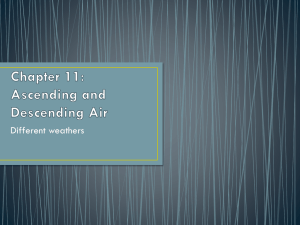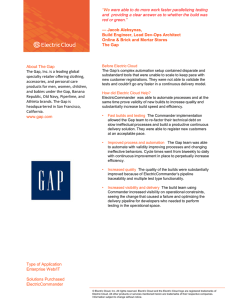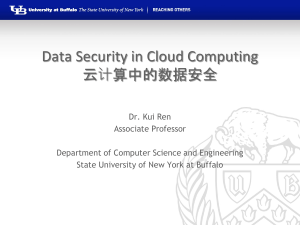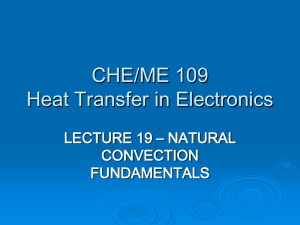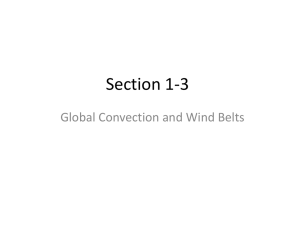PowerPoint-presentatie
advertisement
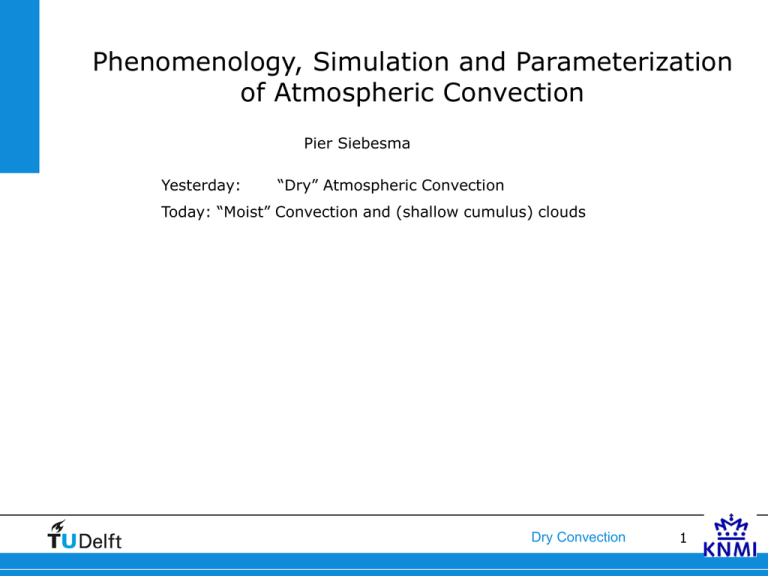
Phenomenology, Simulation and Parameterization
of Atmospheric Convection
Pier Siebesma
Yesterday:
“Dry” Atmospheric Convection
Today: “Moist” Convection and (shallow cumulus) clouds
Dry Convection
1
1. Motivation
2. Equations
3. Moist Thermodynamics Concepts
4. LES of shallow cumulus convection
5. Parameterization of cumulus convection
6. Geometry of Cumulus Clouds
7. (PDF cloud schemes)
Dry Convection
2
Tropopause
10km
Subsidence
~0.5 cm/s
inversion
10 m/s
Cloud base
~500m
Equator
0
o
Ev
Trade wind
Ev
region
North
o
30 N
•Deep Convective Clouds
•Shallow Convective Clouds
•Stratocumulus
•Precipitation
•Little precipitation
•Vertical turbulent transport
•Vertical turbulent transport
•Interaction with
radiation
• Net latent heat production
•No net latent heat production
•Engine Hadley Circulation
•Fuel Supply Hadley Circulation
EUROCS intercomparison
project on cloud representation
in GCM’s in the Eastern Pacific
Large Scale Models tend to
overestimate Tradewind cumulus
cloudiness and underestimate
Stratocumulus
Deep cu
Shallow cu
Siebesma et al. (2005, QJRMS)
scu
1. Motivation
2. Equations
3. Moist Thermodynamics Concepts
4. LES of shallow cumulus convection
5. Parameterization of cumulus convection
6. Geometry of Clouds
7. (PDF cloud schemes)
Dry Convection
5
Grid Averaged Equations of thermodynamic variables
t
qv
t
ql
t
v
w
v qv
w
v ql
w
z
qv
z
ql
z
Large scale
Large scale
advection
subsidence
xi
ui
xi
xi
uiqv
uiql
turbulent
transport
L
cp
c e
Qrad
c e
c e
Net
Condensation
Rate
Pr
Introduce moist conserved variables!
l
L
c p
ql
qt qv ql
l
t
qt
t
v l w
v qt w
•Liquid water potential Temperature
•Total water specific humidity
l
z
qt
z
z
z
w l Qrad
wqt Pr
What happened with the clouds?
Buoyancy is the primary source for the vertical velocity
w
t
With:
g
0
v
v (1 0.61qv ql )
Typical numbers: = 0.5K
v 1 . 61 q v q l
0 .5 K
0 ~ 3K
qv= 1~5 g/kg
ql= 0~3 g/kg
0 ~ 1K
So we need to go back to “down to earth” variables:
Cloud Scheme in LES: All or Nothing
{
a c 0,
{
a c 1,
ql 0,
q l ( q t q sl ),
if
if
q t q sl 0
q t q sl 0
In Climate models we have partial cloud cover
so we need a parameterization.
1. Motivation
2. Equations
3. Moist Thermodynamics Concepts
4. LES of shallow cumulus convection
5. Parameterization of cumulus convection
6. Geometry of Clouds
7. (PDF cloud schemes)
Dry Convection
10
Conditional Instability
•Lift a (un)saturated parcel from a sounding at z0 by dz
•Check on buoyancy with respect to the sounding:
B
g
0
v, p
profile
d
m
Stable for unsaturated parcels
Unstable for saturated parcels
5.4K/km
unstable
z
stable
Conditionally Unstable!!!
v
d
v
z
m
v
Introductory Concepts 1:
CAPE
CAPE = Convective Available Potential
Energy.
CIN
= Convection Inhibition
CAPE
•CAPE and CIN unique properties of moist convection
CIN
•Primary Reason why moist convection is so
intermittant
CAPE and CIN: An Analogue with Chemistry
1) Large Scale
Forcing:
• Horizontal Advection
Activation (triggering)
• Vertical Advection
(subs)
LS-forcing
Surf Flux
• Radiation
CIN
2) Large Scale
Forcing:
CAPE
slowly builds up CAPE
Free
3) CAPE
Energy
•Consumed by moist
convection
RAD
LS-forcing
Mixed Layer
LFC
Parcel Height
LNB
• Transformed in Kinetic
Energy
•Heating due to latent
heat release (as
measured by the
precipitation)
•Fast Process!!
Free after Brian Mapes
Introductory Concepts 3:
Quasi-Equilibrium
(Arakawa and Schubert JAS 1974)
dCAPE
dt
JM
b
F LS 0
LS-Forcing that slowly builds up slowly
The convective process that stabilizes
environment
Quasi-equilibrium: near-balance is maintained even when F
is varying with time, i.e. cloud ensemble follows the Forcing.
Forfilled if : tadj << tF
wu
au
Used convection closure (explicit or implicit)
tadj
JMb ~ CAPE/
tadj : hours to a day.
Mb=au wu r :Amount of convective vertical motion at cloud base (in an ensemble sense)
Introductory Concepts 4:
Earthly Analogue
Free after Dave Randall:
•Think of CAPE as the length of the grass
•Forcing as an irrigation system
•Convective clouds as sheep
•Quasi-equilibrium: Sheep eat grass and no
matter how quickly it grows, the grass is
allways short.
•Precipitation………..
1. Motivation
2. Equations
3. Moist Thermodynamics Concepts
4. LES of shallow cumulus convection
5. Parameterization of cumulus convection
6. Geometry of Clouds
7. (PDF cloud schemes)
Dry Convection
16
History of LES of cumulus topped PBL
1.
Sommeria, G. (1976) J. Atm Sci. 33, 216-241
2.
Sommeria, G and Lemone, M.A (1978) J. Atm Sci. 35, 25-39
3.
Beniston, M.G. and Sommeria G (1981) J. Atm Sci. 38, 780-797
4.
Bougeault, Ph (1981) J. Atm Sci. 38, 2414-1438
5.
Nicholls, L, Lemone, M.A. and Sommeria, G. (1982) QJRMS 108, 167-190
6.
Cuijpers J,W,M and Duynkerke, P.G, (1993) J. Atm Sci. 50, 2894-3908
7.
Siebesma and Cuijpers J,W,M (1995) J. Atm Sci. 52, 650-666
GCSS; LES intercomparison studies of shallow cumulus:
Experiment
Case
year
BOMEX
Steady state
Trade wind cu
1997
ATEX
Trade wind cu topped
with Scu
1998
ARM
Diurnal Cycle
Cumulus
2000
RICO
Precipitating trade
wind cu
2006
Siebesma et al. JAS 2003
Stevens et al. JAS 2001
Brown et al. QJRMS 2002
Van Zanten et al. in preperation
•No observations of turbulent fluxes.
•Use Large Eddy Simulation (LES)
based on observations
BOMEX ship array (1969)
0
t t large t LES
scale
observed
observed
To be modeled by LES
Nitta and Esbensen 1974 JAS
•11 different LES models
•Initial profiles
•Large scale forcings prescribed
•6 hours of simulation
Is LES capable of
reproducing the steady state?
•Large Scale Forcings
•Mean profiles after 6 hours
•Use the last 4 simulation hours for analysis of …….
•Turbulent Fluxes of the conserved
variables qt and l
w l w
L
cp
wql
wqt wqv wql
Cloud layer looks like a enormous entrainment layer!!
Convective Mass flux decreasing
with height
mass flux = cloud core fraction * core velocity
LES: “clouds in silico”
Siebesma et al JAS 2003
x
x
=
Recently validated for “Clouds in vivo” (Zhang, Klein and Kollias 2009)
clouds “in vivo”
ARM mm-cloud radar
Updraft mass flux = updraft fraction * updraft velocity
Conditional Sampling of:
•Total water qt
•Liquid water potential temperature l
Lateral Mixing between clouds and environment
1. Motivation
2. Equations
3. Moist Thermodynamics Concepts
4. LES of shallow cumulus convection
5. Parameterization of cumulus convection
6. Geometry of Clouds
7. (PDF cloud schemes)
Dry Convection
26
Mass Flux decomposition
a
u u u
e e e
u
u
e
a u (1 a ) e
Courtesy : Martin Kohler (ECMWF)
M
u
e
w a w u (1 a ) w e a w u ( u )
sub-core flux env. flux
Siebesma and Cuijpers JAS (1995)
M-flux
e
In general: bulk approach:
Cloud ensemble:
approximated by
1 effective cloud:
How to estimate updraft fields and mass flux?
The old working horse:
Betts
1974 JAS
Arakawa&Schubert
1974 JAS
Tiedtke
1988 MWR
Gregory & Rowntree
1990 MWR
Kain & Fritsch
1990 JAS
And many more……..
Entraining plume model:
c
z
1 M
M z
(c ) for l , qt
M
2
1 wc
2 z
b wc aB,
2
B
g
0
v v
Plus boundary conditions
at cloud base.
Different tendency to form cumulus anvils is caused by
differences in the vertical structure of model mass flux:
, values fixed
Mixing; Flexible structure
M
M
Siebesma et al 2007 (JAS)
Tiedtke (1989) in IFS
EDMF-DualM
Neggers et al 2009
(JAS)
Standard (schizophrenic) parameterization approach:
w K
z
w M ( u )
t
z
w S
This unwanted situation has led
to:
•Double counting of
processes
•Problems with transitions
between different regimes:
dry pbl shallow cu
scu shallow cu
shallow cu deep cu
Deterministic versus Stochastic Convection (1)
•Traditionally convection parameterizations are deterministic:
•Instantaneous large scale Forcing and mean state is taken as input and convective response is
deterministic
•One to one correspondency between sub-grid state and resolved state assumed.
•Conceptually assumes that spatial average is a good proxy for the ensemble mean.
~500 km
Deterministic versus Stochastic Convection (2)
•However: Cloud Resolving Models (CRM’s) indicate that operational resolutions
show considerable fluctuations of convective response around the ensemble
mean.
•This suggests that a deterministic (micro-canonical) approach might be too
restricitive for most operational resolutions.
pdf
Mass Flux
Plant and Craig 2006 JAS
More Sophisticated Parameterization (2)
(Plant and Craig 2007)
Parameterization:
•Select N cloud updrafts stochastically according to the pdf
•Calculate impact for each updraft by using a cloud updraft model
•Note : N is a function of the resolution
•Only tested in 1D setting
1. Motivation
2. Equations
3. Moist Thermodynamics Concepts
4. LES of shallow cumulus convection
5. Parameterization of cumulus convection
6. Geometry of Clouds
7. (PDF cloud schemes)
Dry Convection
35
Is this a Cloud??
….and, how to answer this question?
Fractal Geometry
“Shapes, which are not fractal, are the exception. I
love Euclidean geometry, but it is quite clear that it
does not give a reasonable presentation of the world.
Mountains are not cones, clouds are not spheres,
trees are not cylinders, neither does lightning travel in
a straight line. Almost everything around us is nonEuclidean”.
Benoit Mandelbrot
Instead of
Area-Perimeter analyses of cloud patterns (1)
Procedure:
•Measure the projected cloud area Ap and the perimeter Lp of each cloud
•Define a linear size through l
Ap
• Perimeter dimension define through:
For “ordinary” Euclidean objects:
log L p
Slope: Dp= 1
log l
Lp l
Dp
Area-Perimeter analyses of cloud patterns (2)
•Pioneered by Lovejoy (Science 1982)
•Area-perimeter analyses of projected cloud patterns using satellite and radar data
•Suggest a perimeter dimension Dp=4/3 of projected clouds!!!!!
•Confirmed in many other studies since then…
Instead of
Consequences:
•Cloud perimeter is fractal and hence self-similar in
a non-trivial way.
•Makes it possible to ascribe a (quantitative) number
that characterizes the structure
•Provides a critical test for the realism of the
geometrical shape of the LES simulated clouds!!!!
Slope 4/3
Similar analysis with LES clouds
•Measure Surface As and linear size
l V
1/ 3
of each cloud
•Plot in a log-log plot
• S (l ) l D s
•Assuming isotropy, observations would suggest Ds=Dp+1=7/3
Siebesma and Jonker Phys. Rev Letters (2000)
Result of one cloud field
Repeat over 6000 clouds
Some Direct Consequences
Surface area can be written as a function of resolution (measuring stick) l :
l
S (l ) S L
L
2 Ds
, l L
Ds 7 / 3
With L=outer scale (i.e. diameter of the cloud) and
measured with L.
SL L
2
the normalizing area if
•Euclidian area SL underestimates true cloud surface area S(l=) by a factor
L
2 Ds
100
•LES model resolution of l=50m underestimates cloud surface area still by a
factor 5!!!
•Does this have consequences for the mixing between clouds and the
environment???
Resolution dependence
l0
for transport over cloud boundary (1)
Transport = Contact area x Flux
T (l0 ) S (l0 ) F (l0 )
turbulence
S (l0 ) K (l0 )
diffusive flux
Subgrid
diffusion
resolved
advection
S ( l0 )
K (l0 )
c
x
c
x
Consequences for transport over cloud boundary (2)
T (l0 ) S (l0 ) F (l0 )
l0
S (l0 ) S L
L
2 Ds
S (l0 ) K (l0 )
c
l0
l0
K ( l 0 ) l 0 u ( l 0 ) l 0 u ( L )
L
(Richardson Law)
l0
T ( l0 ) c u ( L ) S ( L )
L
7 / 3 Ds
!!!!!
No resolution dependancy for Ds=7/3!!
1/ 3
Is this shear luck ????
Not really:
Repeat the previous arguments for
l0
T ( ) c u ( L ) S ( L )
L
7 / 3 Ds
Boundary flux T only Reynolds independent if
Re
3 /4 7 /3 - D s
Ds 7 / 3
which completes a heuristic “proof” why clouds are fractal with a surface
dimension of 7/3.
Gradient Percolation
Dp=4/3
A stronger underlying mechanism ?
(Peters et al JAS 2009)
Dry Convection
47
high
Conceptual models
Statistical Mechanics
Self-Organised Criticality
Level of
Interface &
Mixed layer
“understanding”
microphysical
models
Models/Parameterizations
models
or
conceptualisation
Direct
Large
Global
Numerical
Eddy
Climate
Simulation
Simulations
Simulations
low
Laboratory
experiments
Atmospheric
Field
Profiling
campaigns
stations
High
Satellite
Simulations
Observations
data
Low
resolution
Scale Hierarchy
